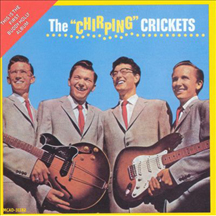The Crickets are an American rock and roll band from Lubbock, Texas, formed by singer/songwriter Buddy Holly in the 1950’s. Their first hit record was “That’ll Be the Day”, released in 1957 and a number-one hit on the Billboard Hot 100 chart. They helped set the template for subsequent rock bands such as the Beatles, with their guitar-bass-drums arrangements and tendency to write their own material. After Holly’s death in 1959, the band continued to tour and record with different vocalists, releasing new material into the 21st century. (More from Wikipedia)
At the top of the list of “might have been” in rock and roll has to be the crash on February 3, 1959 in an Iowa cornfield of a small airplane carrying three early rockers to their graves: Buddy Holly, Ritchie Valens, and The Big Bopper. The stories around this tragic event include those about several men who were not on the plane for one reason or another, most famously future country music star Waylon Jennings, who had recently joined Buddy Holly’s band after the break-up of his previous band the Crickets. Also, Dion DiMucci (of Dion and the Belmonts) couldn’t afford the $36 cost, so he also decided not to board the plane.
* * *
Buddy Holly and his band – by now known as the Crickets (they noticed crickets chirping in the studio one time while they were recording, or so the film The Buddy Holly Story maintains) – then began working at Norman Petty’s studio in New Mexico, concentrating in particular on what they considered their strongest song, “That’ll Be the Day” that they had never been able to satisfactorily record in the Decca studios. The recording was brought to the attention of Bob Thiele, an executive at Coral Records; though Thiele liked it, others at Coral were unenthusiastic.
Nevertheless, in March 1957, the Crickets signed with Brunswick Records. In order to avoid problems with Decca Records – even though Brunswick was a Decca subsidiary – Buddy Holly was not listed as a member of the Crickets on the original recording contract. Not surprisingly, this would create serious legal and financial problems for Buddy Holly in the future.
According to Norman Petty, “That’ll Be the Day” by the Crickets was released in May 1957 to “humor” Bob Thiele. The song became a #1 hit that summer; and before long, the jig was up as Decca Records executives realized that Buddy Holly was their bandleader. However, as Cyndi Lauper observed in her 1984 hit song, “Money Changes Everything”, so Decca Records released Buddy Holly from his original contract restriction. As a condition though, Buddy Holly was signed individually to Coral Records (yet another Decca subsidiary); thus, Buddy Holly was in the unusual position of being bound by two recording contracts at the same time – his earlier contract as a member of the Crickets and this new one as an individual artist.
The confusion spread to the general public as well, since some of his 45’s were released under the name Buddy Holly, and others as the Crickets (often with Holly’s name nowhere in sight, even as a songwriter). In spite of this, Buddy Holly and/or the Crickets had numerous hit songs, among them “Not Fade Away”, “Everyday”, “Listen to Me”, “Oh Boy!”, “Peggy Sue”, “Maybe Baby”, “Rave On”, “Heartbeat”, and “It’s So Easy”.
Holly released just three albums during his lifetime, all under different names: The Chirping Crickets by the Crickets on Brunswick Records in 1957; Buddy Holly by Buddy Holly on Coral Records in 1958; and That’ll Be the Day by Buddy Holly & the Three Tunes on Decca Records, also in 1958. The latter album was an attempt by Decca to cash in on Holly’s fame by releasing the songs from Buddy Holly’s 1956 studio recordings from his original contract with Decca.
* * *
Buddy Holly split from both the Crickets and Norman Petty in the fall of 1958 and was thus free to pursue his new musical visions. Unfortunately, he got only a meager settlement when Norman Petty’s books were found to be in hopeless disarray – probably Petty took a big slice of the pie for himself, though there was no way to prove it.
With a new, pregnant wife, and short on money, Buddy Holly signed on for the “Winter Dance Tour” package tour of the Midwest. It was during this tour that Holly was killed in the airplane crash in February 1959, along with Ritchie Valens, The Big Bopper. and the pilot Roger Peterson. Buddy Holly was just 22 years old.
More than a few British rock groups adopted band names in tribute to Buddy Holly. The Beatles in part took their insect-oriented name from that of his band the Crickets. One Manchester band of the British Invasion period simply called themselves the Hollies. Yet another British Invasion band, the Searchers took their name from the John Wayne movie of that name, The Searchers, where the Duke often said, “That’ll be the day”; the catch phrase had been adopted by Buddy Holly as the name of one of his first hits, “That’ll Be the Day”.
(June 2013/1)















